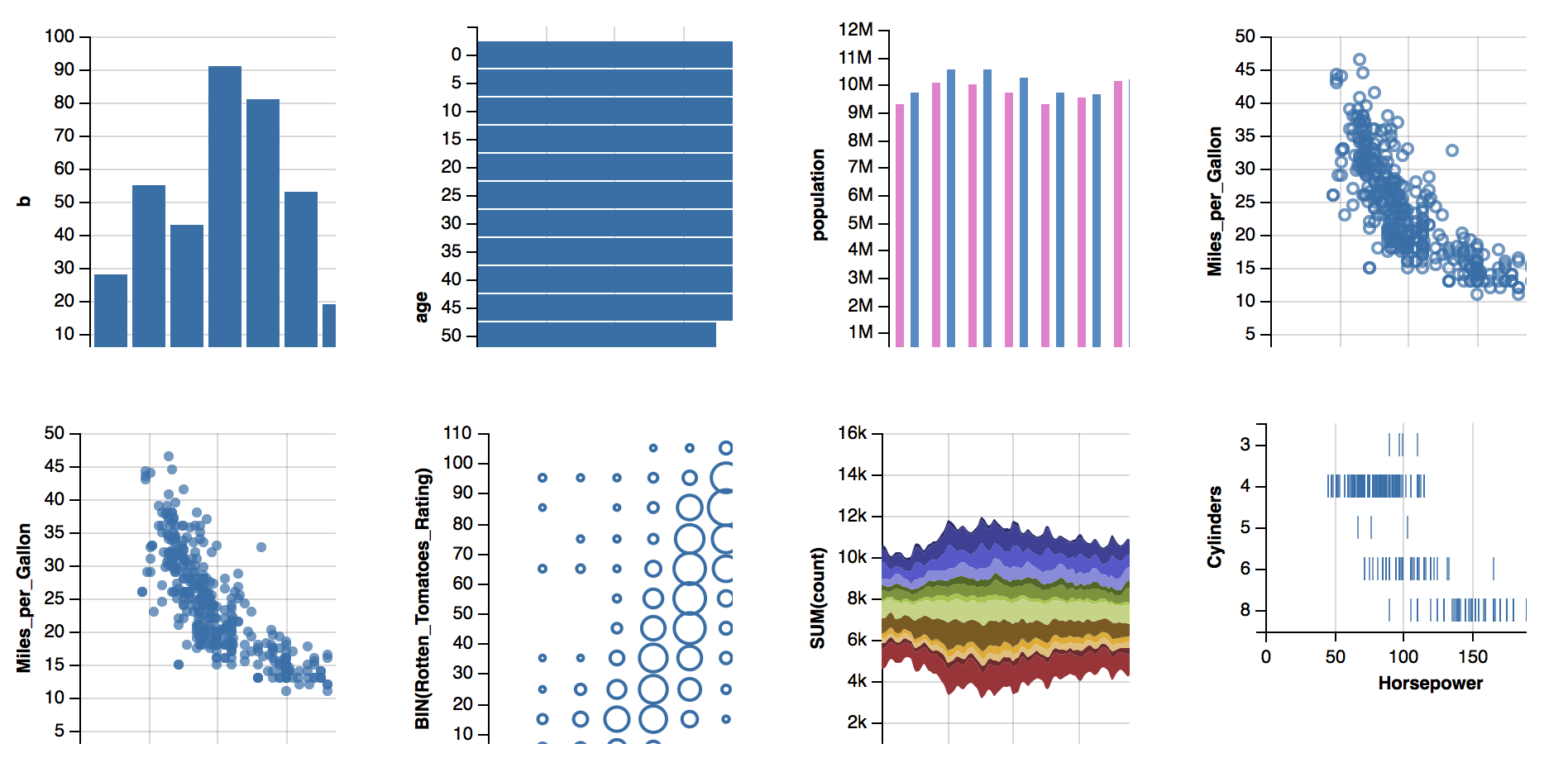vegalite : Do whatever ggvis doesn't :-)
For better examples, take a look here.
There's also a blog post describing this in a bit more detail.
The vegalite package has been updated to Vega-Lite 2.0, but is not yet 100% feature-complete.
In addition to functions for making a Vega-Lite based htmlwidget, functions also exist which enable creation of widgets from a JSON spec and turning a vegalite package created object into a JSON spec.
You start by calling vegalite() which allows you to setup core configuration options, including whether you want to display links to show the source and export the visualization. You can also set the background here and the viewport_width and viewport_height. Those are very important as they control the height and width of the widget and also the overall area for the chart. This does not set the height/width of the actual chart. That is done with view_size().
Once you instantiate the widget, you need to add_data() which can be data.frame, local CSV, TSV or JSON file (that convert to data.frames) or a non-realive URL (wich will not be read and converted but will remain a URL in the Vega-Lite spec.
You then need to encode_x() & encode_y() variables that map to columns in the data spec and choose one mark_...() to represent the encoding.
Here's a sample, basic Vega-Lite widget:
dat <- jsonlite::fromJSON('[
{"a": "A","b": 28}, {"a": "B","b": 55}, {"a": "C","b": 43},
{"a": "D","b": 91}, {"a": "E","b": 81}, {"a": "F","b": 53},
{"a": "G","b": 19}, {"a": "H","b": 87}, {"a": "I","b": 52}
]')
vegalite() %>%
add_data(dat) %>%
encode_x("a", "ordinal") %>%
encode_y("b", "quantitative") %>%
mark_bar() -> vl
vl
That is the minimum set of requirements for a basic Vega-Lite spec and will create a basic widget.
You can also convert that R widget object to_spec() which will return the JSON for the Vega-Lite spec (allowing you to use it outside of R).
to_spec(vl)
{
"description": "",
"data": {
"values": [
{ "a": "A", "b": 28 }, { "a": "B", "b": 55 }, { "a": "C", "b": 43 },
{ "a": "D", "b": 91 }, { "a": "E", "b": 81 }, { "a": "F", "b": 53 },
{ "a": "G", "b": 19 }, { "a": "H", "b": 87 }, { "a": "I", "b": 52 }
]
},
"mark": "bar",
"encoding": {
"x": {
"field": "a",
"type": "nominal"
},
"y": {
"field": "b",
"type": "quantitative"
}
},
"config": [],
"embed": {
"renderer": "svg",
"actions": {
"export": false,
"source": false,
"editor": false
}
}
}
If you already have a Vega-Lite JSON spec that has embedded data or a non-realtive URL, you can create a widget from it via from_spec() by passing in the full JSON spec or a URL to a full JSON spec.
If you're good with HTML (etc) and want a more lightweight embedding options, you can also use embed_spec which will scaffold a minimum div + script source and embed a spec from a vegalite object.
If you like the way Vega-Lite renders charts, you can also use them as static images in PDF knitted documents with the new capture_widget function. (NOTE that as of this writing, you can just use the development version of knitr instead of this function.)
devtools::install_github("hrbrmstr/vegalite")library(vegalite)
# current verison
packageVersion("vegalite")## [1] '2.0.0.9999'
library(vegalite)
vegalite() %>%
cell_size(400, 400) %>%
add_data("https://vega.github.io/vega-editor/app/data/cars.json") %>%
encode_x("Horsepower") %>%
encode_y("Miles_per_Gallon") %>%
encode_color("Origin", "nominal") %>%
mark_point()Please note that this project is released with a Contributor Code of Conduct. By participating in this project you agree to abide by its terms.

